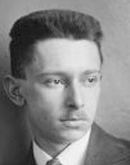

Otto Rothmayer
*28. 2. 1892 – Prague, Czech Republic
†24. 9. 1966 – Prague, Czech Republic
Biography
Otto Rothmayer was born in Prague on February 28, 1892, and learned carpentry, his father's trade. Just before World War I, he began studying at the Prague School of Applied Arts. There, he became a pupil of Slovenian architect Josip Plečnik, and his timeless creations, drawing from the legacy of Mediterranean cultures, influenced Rothmayer for his entire life. He became not only Plečnik's student but also his successor. Otto Rothmayer completed his architectural practice in the studios of Plečnik's friend from UMPRUM, Professor Ladislav Skřivánek, and then with two protagonists of new architectural trends, Pavel Janák and Josef Gočár. At that time, he also participated in the design and realization of Gočár's wooden pavilion for the Czechoslovak Republic at the Lyon Exhibition in 1920. Ultimately, however, he settled in the castle studio of Josip Plečnik, who had then become the architect of Prague Castle on the recommendation of the Mánes association. When Plečnik definitively left for his native Ljubljana in 1921, where he led the newly established architectural school and contributed to the new city concept, Rothmayer took over all of his tasks. He faced the challenging duty of overseeing the execution of Plečnik's designs sent to the Castle from the Ljubljana studio. It was also an opportunity to design part of the interior furnishings for President Masaryk's apartment. After 1930, Rothmayer had the opportunity to work independently on the reconstruction of the so-called Theresian Wing of the Old Royal Palace. It was reduced and supplemented with a delicate spiral staircase - still one of the most impressive elements of the entire complex. Rothmayer also adapted adjacent spaces and interiors for the permanent exhibition of the history of Prague Castle. The demanding work was completed only on the threshold of the 1950s. The new castle architect after Plečnik, Pavel Janák, allowed Rothmayer to continue working on the completion of some concepts, primarily the imposing hall, which still bears his name, and the Wedge Corridor with the ceremonial entrance to the Spanish Hall. Among Otto Rothmayer's smaller realizations were some interior adaptations in the New Palace, a memorial to the fallen in the Deer's Moat, and the forest management building in the Lány game preserve. Professor Rothmayer had to leave the work at the Castle unfinished after being removed from his position, and he even witnessed their devastation later on. He spent his old age in a villa in Břevnov, which he designed himself. In its garden, the famous photographic cycles of his friend Josef Sudek were created.
The English translation is powered by AI tool. Switch to Czech to view the original text source.










